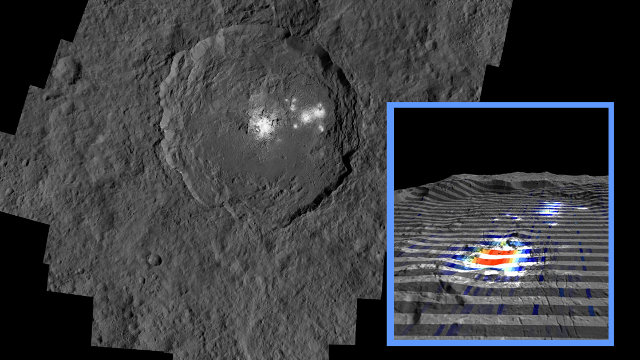
An article published in the journal “Nature” describes a new research on the famous white spots in the dwarf planet Ceres’ Occator Crater. According to a team led by Maria Cristina De Sanctis, INAF – IAPS, the most abundant mineral is sodium carbonate. It’s a surprising result because that’s a salt that on Earth is abundant in hydrothermal sources and this raises the possibility of the presence of liquid water in Ceres underground.
Maria Cristina De Sanctis is the principal investigator of Dawn space probe’s VIR spectrometer and is an expert of the dwarf planet Ceres. Last year, she conducted another research that led to the discovery of ammonia on its surface, another surprise because this compound is abundant in the outer solar system, not in the asteroid belt.
This time the team led by Dr. De Sanctis team focused on Occator crater to try to finally solve the mystery of the large white spots inside it. Already several clues suggested that the so-reflective substance was some kind of salt but there were only hypotheses about its nature. Now the analysis of the data collected by the VIR spectrometer during the Dawn mission points to sodium bicarbonate and in an amount never seen elsewhere in the solar system.
This discovery sheds new light on Occator crater and the presence of water on Ceres. The crater’s age is estimated to be about 80 million years, not much from a geological point of view. The salts in the white spots appear to have come out from inside Ceres, suggesting that the temperatures underground are higher than expected. Minerals of this type form in an interaction with water, an important clue to the presence of a hydrothermal activity that pushed them up to the surface.
The new research also confirmed the presence of ammonia in other salts, specifically ammonium chloride and ammonium bicarbonate. It’s a further link with the outer solar system because ammonia, sodium carbonate and hydrothermal sources were discovered on Enceladus, Saturn’s moon, which is one of the potential environments that could host life in the solar system with its underground ocean.
From the beginning of the Dawn mission, one of the most interesting possibilities was that under the surface of Ceres there could be liquid water as well. It’s possible that among the minerals that make up this dwarf planet there’s a good amount of olivine. This mineral can be transformed as a result of a process called serpentinization, which produces heat.
Officially, on June 30, 2016, the Dawn space probe completed its primary mission. It has already supplied a wealth of very interesting scientific data about the giant asteroid Vesta and now the dwarf planet Ceres too. We’re waiting for NASA’s decisions on the future of Dawn, meanwhile the scientists keep on working on the data already collected.


Permalink
Permalink
Permalink
Permalink